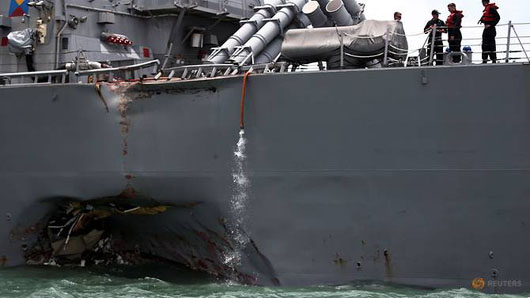by WorldTribune Staff, August 21, 2017
The USS John McCain guided-missile destroyer’s collision with an oil tanker in the early morning hours of Aug. 21 off the coast of Singapore marks the fourth incident involving the U.S. Pacific Fleet this year.
Five U.S. sailors were injured and 10 are reported missing. Four of the five injured sailors were taken by helicopter to the Singapore General Hospital with non-life threatening injuries. The fifth sailor did not need further medical attention, the U.S. Navy said.

In the wake of the Aug. 21 incident, Adm. John Richardson, the chief of naval operations, called for a temporary halt in operations for the Pacific-based 7th Fleet, the forces that operate around Japan.
“He has put together a broader inquiry to look into these incidents and to determine any of the causal factors to determine what’s going on,” Defense Secretary James Mattis told reporters while traveling in Amman, Jordan.
The USS John McCain collided with the Alnic, a 30,000-ton, 600-foot-long oil tanker. The Liberian-flagged vessel was carrying nearly 12,000 tons of fuel oil from Taiwan to discharge in Singapore, according to the ship’s crew.
The U.S. Navy said that the USS John McCain had sustained “significant damage to the hull,” resulting in flooding to nearby compartments including crew berthing, machinery and communications rooms.
In January, the cruiser Antietam ran aground in Tokyo Bay near its home port of Yokosuka, Japan. In May, another cruiser, the Lake Champlain, collided with a small fishing boat off the Korean peninsula.
A month later, seven sailors drowned when the destroyer USS Fitzgerald collided with the cargo ship ACX Crystal off Japan’s coast.
The two top officers aboard Fitzgerald were relieved of their duties earlier this month, and the Navy’s Seventh Fleet said “flawed watch stander teamwork and inadequate leadership contributed to the collision.”
All four of the U.S. ships involved in the incidents are equipped with the highly sophisticated Aegis sensor suite that can supposedly track over 100 targets simultaneously, according to the U.S. Navy website.
Ridzwan Rahmat, a senior analyst at defense consultancy Jane’s by IHS Markit, told NBC’S Today that initial indications suggested that USS John McCain may not have been obeying rules designed to separate maritime traffic passing through the Singapore Strait, adding that vessels approaching the high-traffic Singapore Strait are governed by a regime known as the Traffic Separation Scheme (TSS). “Initial analysis by Jane’s suggest that the tanker was in compliance with the TSS.”
Ridzwan also told AFP that the incident has raised questions “whether there is crew fatigue setting in, whether or not the tempo of operations by the U.S. Navy in this region is getting too fast. Are they doing too much within this region with North Korea, and Japan and then now in the South China Sea?”
A senior U.S. Navy officer told The New York Times that night-time duty on American warships like the McCain is often handled by young officers aged between 22 and 24. They are backed up by officers working the radar and looking out from the command center below the bridge. For the McCain to have hit the Alnic oil tanker, a handful of separate functions in the safety chain must have failed, the officer said.
The blame should not sit entirely with the U.S. warships involved in the recent incidents, said former naval officer Chang Jun Yan. “In such collisions, both parties are responsible, and this is a point often overlooked in previous commentaries regarding the USS Fitzgerald,” he said. “Much has been made of the Fitzgerald being the vessel that should give way to the ACX Crystal, but the latter also needs to take appropriate action to avoid collision.”
Bonji Ohara, a research fellow at the Sasakawa Peace Foundation in Tokyo, said that while naval ships tend to have live crews on watch, most commercial ships work on autopilot mode to reduce costs, which can lead to problems in busy sea lanes. Commercial tankers might be reluctant to shift their course because maneuvering requires turning off the autopilot, which costs time and money.
Subscribe to Geostrategy-Direct __________ Support Free Press Foundation
